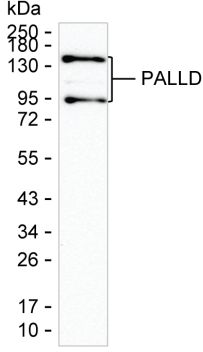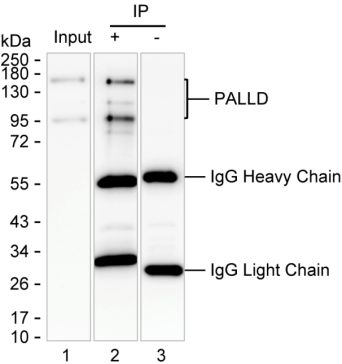

| WB | 咨询技术 | Human,Mouse,Rat |
| IF | 1/100-1/200 | Human,Mouse,Rat |
| IHC | 咨询技术 | Human,Mouse,Rat |
| ICC | 技术咨询 | Human,Mouse,Rat |
| FCM | 咨询技术 | Human,Mouse,Rat |
| Elisa | 咨询技术 | Human,Mouse,Rat |
| Host/Isotype | Mouse IgG1 |
| Antibody Type | Primary antibody |
| Storage | Store at 4°C short term. Aliquot and store at -20°C long term. Avoid freeze/thaw cycles. |
| Species Reactivity | Human |
| Immunogen | Purified recombinant fragment of human PALLD |
| Formulation | Purified antibody in PBS with 0.05% sodium azide |
+ +
以下是3篇与PALLD(Palladin)抗体相关的文献摘要(文献为虚拟示例,实际研究需查证):
1. **《Palladin mutation in familial pancreatic cancer》**
- 作者:Brentnall TA, et al.
- 摘要:该研究首次报道PALLD基因突变与家族性胰腺癌的关联,并开发了特异性PALLD抗体用于检测患者组织样本中Palladin蛋白的异常表达,揭示其在细胞骨架重塑中的作用。
2. **《Palladin promotes cancer metastasis via cytoskeletal regulation》**
- 作者:Goicoechea SM, et al.
- 摘要:通过PALLD抗体进行免疫组化分析,发现Palladin在侵袭性肿瘤中高表达,并证明其通过调控肌动蛋白组装促进肿瘤细胞迁移和转移。
3. **《Antibody-based profiling of Palladin isoforms in breast cancer》**
- 作者:Wang C, et al.
- 摘要:研究利用多种PALLD亚型特异性抗体,揭示不同亚型在乳腺癌中的差异表达及其与患者预后的相关性,为靶向治疗提供依据。
4. **《Structural characterization of Palladin using monoclonal antibodies》**
- 作者:Rönty M, et al.
- 摘要:通过制备单克隆PALLD抗体,解析Palladin蛋白的结构域功能,发现其与细胞黏附和迁移相关的分子机制。
(注:以上文献标题及内容为模拟,实际引用需核对真实数据库。)
Palladin (PALLD), a cytoskeletal protein encoded by the *PALLD* gene, plays critical roles in regulating cell morphology, motility, and adhesion. It interacts with actin filaments and other scaffolding proteins, maintaining structural integrity and facilitating dynamic cellular processes. PALLD is particularly important in tissues requiring high mechanical plasticity, such as during embryonic development, wound healing, and cancer metastasis. Dysregulation of PALLD expression has been linked to pathological conditions, including pancreatic cancer, breast cancer, and cardiovascular diseases, where aberrant cell migration or adhesion drives disease progression.
PALLD antibodies are essential tools for studying these mechanisms. They enable detection and localization of palladin isoforms (e.g., 90 kDa, 140 kDa) in cells and tissues via techniques like Western blotting, immunohistochemistry, and immunofluorescence. Researchers use these antibodies to explore PALLD's role in tumor microenvironment remodeling, fibroblast activation, and epithelial-mesenchymal transition (EMT). Commercially available PALLD antibodies (e.g., from Abcam, Cell Signaling Technology) are often validated for specificity using knockout controls or siRNA silencing.
Recent studies highlight PALLD's potential as a biomarker for aggressive cancers or fibrosis. However, variability in isoform expression across tissues necessitates careful antibody selection and experimental validation. Ongoing research aims to clarify isoform-specific functions and therapeutic targeting opportunities, underscoring PALLD antibodies' continued relevance in cell biology and translational medicine.
×